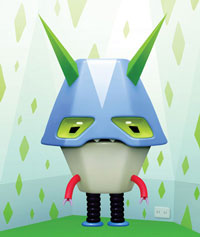Interview with Jeremy Dower
by Renae Mason
(This has been edited with corrections subsequent to the print version – eds 2/8/07)
Jeremy Dower’s wide-eyed, soft-spoken manner hints at his special talent for developing imaginary realms.
As a young boy growing up in country Bendigo he entertained himself with drawing, painting, drums and guitar. He recalls that the cruellest punishment his parents could wield was to lock him out of the room while his kindred folk enjoyed the magical world of Astro Boy, a sentient kid robot with an evolving sense of humanity. Hailing from a self-professed working-class background, Jeremy notes that while he was broadly interested in creative pursuits he never anticipated how that would transpire into a successful hobby producing electronic music and a career in film as a character designer and concept artist.

His first real break was designing pixel art for games, “No one said to me, ‘you can work as an artist, you can make money, you can have a job that you really enjoy’. I sort of came from the perspective that you have to get a job, you have to work, everyone has to do things they don’t like. And then to get into a creative industry like that was a real breakthrough and that was good because I was being paid to learn software and develop my skills.”
Working in the gaming industry allowed him space to hone his talent for developing characters with rich emotional lives, attitudes and quirks. They do not fight and bear no weapons, but are imbued with special knowledge. They evoke their own sets of mysteries. Some are cute and playful, others dark and brooding, weird or sad. They all wish for you to understand them and seek a space for life in tiny corners of hearts and minds. Jeremy’s gentle nature shines through them, dissolving transitional borders that separate children from adults.


Looking at his current work, I’m curious as to whose ideas and artistic expressions he finds most inspiring now. After a short pause he replies, “In terms of the whole package, I really like FriendsWithYou (a Miami-based collective). I really admire their ability to combine art and commerce with no tension. They direct a commercial and then they have an exhibition of inflatable toys and they don’t draw a line between the two. Like Jeff Koons really, ‘make stuff people like and make lots of money’.”
This approach is, for Jeremy, the antidote to the disillusionment that he experienced as an undergraduate student in fine arts. “I think definitely, going to university in Melbourne… the art scene is really Left and as a young person to say ‘I want to make lots of money with art’, it would have been sacrilegious. I never really thought about it until I went to Japan and there’s not really a scene of unemployed artists who have the luxury of having such high ideals about it. It’s like, if you want to make fun stuff you have to make fun stuff that people want to buy. And it makes perfect sense to me because you can stay at home in your bedroom painting and making music that nobody will ever hear. Maybe you will enjoy it, but it seems like a waste of time to me.”


Perhaps as a response to his waning dissatisfaction with the culture around him and his chosen course of study, Jeremy also turned to music for creative inspiration. His first album is a DIY production that never really hit any great heights as far as distribution went. Produced on a 386 PC running Windows 3.1 it has a beautiful tech-nostalgia about it. Funky little beats and melody lines that bleep their way across an inconsistent tempo, swinging slightly off kilter, this shakiness more an artifact of the medium than an intentional touch, but charming nonetheless.
His second effort was a tad more ambitious. A romantic concept album, Sentimental Dance Music For Couples was picked up by US-based Plug Research, known best for minimalist electronica at the time. With label mates like fellow Melbournian Voiteck, Jeremy quickly found himself a broader audience.
But rocketing out of the local Melbourne scene and into the international sphere soon proved to have both its highs and lows. While double vinyl and CDs were pressed and sales took off steadily, Jeremy never received any monetary benefits from his work. Like many artists it boiled down a misunderstanding of how record labels work – that no money flows to the artist until the label recoups its costs, indie and major alike. Often the artist underestimates the costs involved, especially in marketing a record. It was a bad experience, “If I’d gone into it knowing I wouldn’t make any money, I wouldn’t have been disappointed, but for it to go like that… After that I never made music with the intention of making money from it.”
“Would you like more tea?” he asks with a tiny, awkward chuckle.
Just after the release of the second album Jeremy quit his job in Melbourne and relocated to Japan where a modest following garnered enough success to release a third album titled Music for the Young and the Restless. Working with his new boutique label, A Bit Of Heaven, coverage crept across Japan and soon Jeremy had his own section in the infamous Tower Records.
He describes his style of instrumentation on his releases as, “Old analogue synthesiser on a random cycle imitating the way a double bass slides. It never repeats, but is so monotonous that it sounds like it is. Vibraphone and jazz piano (play) over the top. They are fake, obviously fake, but if you step back with less of a critical ear it sounds like it could be a jazz band.” There were many comparisons to contemporaries like Amon Tobin but Jeremy reiterates that it wasn’t sample based. Instead of remixing records, as is done in the turntable tradition, he imitated the sounds to produce his ‘faux’ jazz.
Despite his successful dabblings with music Jeremy felt a stirring back towards visual art that he attributes largely to his new Tokyo environs, populated by animated characters and their kooky creators. If you’ve ever been to Tokyo you will be accustomed to the omnipresent role that characters hold in society. Afro-Ken (the cool dog with the multi-coloured ‘fro) adorns pens and stationary, strawberries have many moods and dance on the packets of ichi-go Poki treats, the Bathing Ape helps sell streetwear to the J-hop crew, while other make-believe wonders assist celebrities with public service announcements.
Is the kowaii trend (where characters are scary, like a cute bear with killer nails who accidently eats his kid owners) viewed as a stand against the suffocating cuteness of the characters in Japan?
“Western people are positive and excited about it” he says, recalling his visit to Pictoplasma in Berlin, surrounded by peers who were heavily influenced by the vast semiotic landscape of Japanese characters. “A Japanese artist came to talk and he did a modernist Paul Klee style of work. Someone asked him about cute characters and he replied that he hated them.” Given the saturation of ‘cute’ in Japan there is a clear divide between the way Westerners and Japanese respond to these ‘cute’ characters.
Still, there is a commercial downside to the anti-cute movement. They don’t always sell. Two of his characters, Uma and Bliss, were worked up in a Victorian Gothic style for an illustrated children’s book. When presented in all their darkness the publishers decided they wanted it happier and friendlier so in the end the project didn’t get made.
Is Jeremy influenced at all by the American style of animation with its big budget price tags? While confessing to be an early Disney fan, he also finds that, “American animations these days are just so devoid of any content at all. It’s just sad that they are so condescending to children, they don’t really give kids enough credit.”
So what positive kids role-models does Jeremy see in the animation world at the moment?
“I really like Sponge Bob, he’s just a total geek, he’s got square pants and little socks and shiny shoes and stuff and has dorky faces, but he’s really lovable as well. I think that’s a good message for kids.”



